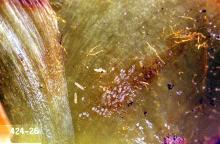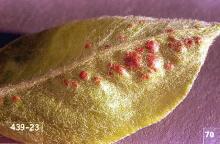Pear rust mite (Epitrimerus pyri)
Pearleaf blister mite (Eriophyes pyri)
Pest description and crop damage Adults of eriophyid mites cannot be seen without magnification. Pearleaf blister mites are light in color, cylindrical, tapered at the posterior end, with two pairs of short legs at the front of the body. The overall appearance is that of a small worm. Nymphs have the overall appearance of the adult, but are even smaller. Adult rust mites are wedge-shaped and yellowish brown with two pairs of legs near the front of the body.
Pearleaf blister mite feeding on leaves causes reddish to yellowish green blisters; blisters turn brown or black as the tissue dies later in the season. Leaves may drop prematurely. Loss of foliage weakens trees, reduces shoot growth, and interferes with fruit maturation and fruit bud formation. Feeding on fruit causes irregular, russeted spots. Feeding by pear rust mites on foliage causes bronzing of the leaves, while feeding on the fruit causes russeting, especially around the calyx end but can extend over most of the fruit. Non-russeted cultivars like Anjou and Bartlett are particularly susceptible.
Biology and life history Eriophyid mites overwinter as mature females under outer bud scales. As buds swell in the spring, the mites begin to disperse and will infest developing leaves and fruitlets. Several generations per year may develop, eventually the mites will move to growing terminals. Fruit damage by blister mites is caused by feeding injury to buds before bloom-mites do not reside in the blisters on fruit. Eriophyid mites move from tree to tree, perhaps by wind or carried on birds or insects.
Pest monitoring Scouting for pearleaf blister mite is not effective during the current season, as by the time blisters are noticed the damage is done. Plan on taking action the following fall or spring if damage is noted. If pear rust mites are observed at any time then control may be warranted to limit any further fruit russeting.
Management-chemical control: HOME USE
Dormant-season spray
- lime sulfur-Applications in the fall can significantly reduce populations of both these mites the following year. Application in the spring before bud swell can also be effective. Some formulations are OMRI-listed for organic use.
- superior oil-Apply as buds begin to swell. Some formulations are OMRI-listed for organic use.
Growing-season spray
- carbaryl-Highly toxic to bees.
- pyrethrins-Some formulations are OMRI-listed for organic use. Highly toxic to bees.
Management-chemical control: COMMERCIAL USE
Delayed-dormant spray
- lime sulfur (Calcium polysulfide)-Formulations vary; see label for rates. May be mixed with horticultural mineral oil; see label for rates. REI 48 hr. Some formulations are OMRI-listed for organic use.
- micronized sulfur (Microthiol Disperss) at 10 to 20 lb/A. Apply with oil at labeled rates. REI 24 hr. If used after delayed dormant micronized sulfur may injure some varieties. Some formulations are OMRI-listed for organic use.
Growing-season spray for control of pear rust mite
- abamectin (Agri-Mek SC) at 2.25 to 4.25 fl oz/A. REI 12 hr. PHI 28 days. Use with an adjuvant; see label.
- carbaryl (Sevin SL) at 1.5 to 3 quarts/A. REI 12 hr. PHI 3 days. Application to pears <20mm in size may result in fruit thinning and deformed fruit.
- fenbutatin-oxide (Vendex 50WP) at 1.5 to 2 lb/A. REI 48 hr. PHI 14 days. Do not exceed two applications between petal fall and harvest.
- fenpyroximate (FujiMite SC) at 32 oz/A. REI 12 hr. PHI 14 days. Do not exceed one application per season.
- pyridaben (Nexter SC) at 11 to 17 oz/A. REI 12 hr. PHI 7 days. Apply as populations begin to build. Do not exceed one application per season.
- spirodiclofen (Envidor 2SC) at 18 oz/A. REI 12 hr. PHI 7 days. Do not exceed one application per season.
- spirotetramat (Ultor) at 8 to 14 oz/A. REI 24 hr. PHI 7 days. Minimum 14 days between applications. Must be used with an adjuvant; see label. Do not apply prior to petal fall.
- tolfenpyrad (Bexar) at 21 to 27 fl oz/A. REI 12 hr. PHI 14 days.
Post-harvest spray
- lime sulfur (Calcium polysulfide)-Formulations vary; see label for rates. REI 48 hr. Some formulations are OMRI-listed for organic use.
- micronized sulfur (Microthiol Disperss) at 10 to 20 lb/A + horticultural mineral oil at labeled rates. REI 24 hr. Some formulations are OMRI-listed for organic use.



